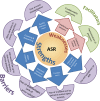Animal Study Registries: Results from a Stakeholder Analysis on Potential Strengths, Weaknesses, Facilitators, and Barriers
- PMID: 27832101
- PMCID: PMC5104355
- DOI: 10.1371/journal.pbio.2000391
Animal Study Registries: Results from a Stakeholder Analysis on Potential Strengths, Weaknesses, Facilitators, and Barriers
Abstract
Publication bias in animal research, its extent, its predictors, and its potential countermeasures are increasingly discussed. Recent reports and conferences highlight the potential strengths of animal study registries (ASRs) in this regard. Others have warned that prospective registration of animal studies could diminish creativity, add administrative burdens, and complicate intellectual property issues in translational research. A literature review and 21 international key-informant interviews were conducted and thematically analyzed to develop a comprehensive matrix of main- and subcategories for potential ASR-related strengths, weaknesses, facilitators, and barriers (SWFBs). We identified 130 potential SWFBs. All stakeholder groups agreed that ASRs could in various ways improve the quality and refinement of animal studies while allowing their number to be reduced, as well as supporting meta-research on animal studies. However, all stakeholder groups also highlighted the potential for theft of ideas, higher administrative burdens, and reduced creativity and serendipity in animal studies. Much more detailed reasoning was captured in the interviews than is currently found in the literature, providing a comprehensive account of the issues and arguments around ASRs. All stakeholder groups highlighted compelling potential strengths of ASRs. Although substantial weaknesses and implementation barriers were highlighted as well, different governance measures might help to minimize or even eliminate their impact. Such measures might include confidentiality time frames for accessing prospectively registered protocols, harmonized reporting requirements across ASRs, ethics reviews, lab notebooks, and journal submissions. The comprehensive information gathered in this study could help to guide a more evidence-based debate and to design pilot tests for ASRs.
Conflict of interest statement
The authors have declared that no competing interests exist.
Comment in
-
Animal registries aim to reduce bias.Nature. 2019 Sep;573(7773):297-298. doi: 10.1038/d41586-019-02676-4. Nature. 2019. PMID: 31501583 No abstract available.
References
MeSH terms
LinkOut - more resources
Full Text Sources
Other Literature Sources
Miscellaneous


